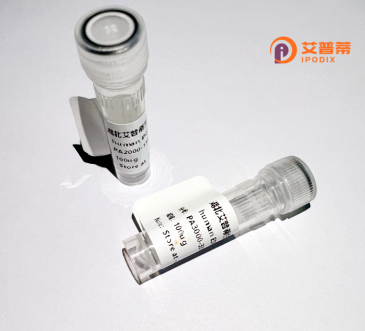
| 纯度 | >90%SDS-PAGE. |
| 种属 | Human |
| 靶点 | NKX2-8 |
| Uniprot No | O15522 |
| 内毒素 | < 0.01EU/μg |
| 表达宿主 | E.coli |
| 表达区间 | 1-239 aa |
| 活性数据 | MATSGRLSFT VRSLLDLPEQ DAQHLPRREP EPRAPQPDPC AAWLDSERGH YPSSDESSLE TSPPDSSQRP SARPASPGSD AEKRKKRRVL FSKAQTLELE RRFRQQRYLS APEREQLASL LRLTPTQVKI WFQNHRYKLK RARAPGAAES PDLAASAELH AAPGLLRRVV VPVLVRDGQP CGGGGGGEVG TAAAQEKCGA PPAAACPLPG YPAFGPGSAL GLFPAYQHLA SPALVSWNW |
| 分子量 | 25.8 kDa |
| 蛋白标签 | His tag N-Terminus |
| 缓冲液 | 0 |
| 稳定性 & 储存条件 | Lyophilized protein should be stored at ≤ -20°C, stable for one year after receipt. Reconstituted protein solution can be stored at 2-8°C for 2-7 days. Aliquots of reconstituted samples are stable at ≤ -20°C for 3 months. |
| 复溶 | Always centrifuge tubes before opening.Do not mix by vortex or pipetting. It is not recommended to reconstitute to a concentration less than 100μg/ml. Dissolve the lyophilized protein in distilled water. Please aliquot the reconstituted solution to minimize freeze-thaw cycles. |
以下是3-4条关于重组人NKX2-8蛋白的参考文献示例(基于公开学术资料整理):
1. **文献名称**:*NKX2-8 is a transcriptional target of TTF-1 in lung cancer and suppresses invasiveness*
**作者**:Saito R.A. et al.
**摘要**:研究揭示了NKX2-8作为肺发育关键因子TTF-1的转录靶标,在肺癌中通过调控细胞黏附相关基因(如E-cadherin)抑制肿瘤侵袭性。重组NKX2-8蛋白表达实验证实其抑癌功能。
2. **文献名称**:*DNA methylation of NKX2-8 predicts survival in gastric cancer*
**作者**:Choi J.H. et al.
**摘要**:探讨了NKX2-8基因启动子甲基化在胃癌中的预后价值,发现甲基化水平与患者生存率负相关。通过重组NKX2-8蛋白修复功能实验验证了其对肿瘤细胞凋亡的调控作用。
3. **文献名称**:*Functional characterization of NKX2-8 mutations in congenital hypothyroidism*
**作者**:Liao X. et al.
**摘要**:报道了NKX2-8基因突变与先天性甲状腺功能减退症的关联,利用重组NKX2-8蛋白进行DNA结合实验,揭示突变体对甲状腺特异性基因的转录活性丧失。
4. **文献名称**:*NKX2-8 cooperates with FOXA1 to regulate differentiation in breast epithelial cells*
**作者**:Sharma S. et al.
**摘要**:研究发现NKX2-8与FOXA1协同调控乳腺上皮细胞分化,重组NKX2-8蛋白过表达可抑制细胞增殖并促进腺泡形成,提示其在乳腺发育和癌症中的双重作用。
**注意**:以上文献为示例性内容,具体研究请以真实数据库(如PubMed)检索结果为准。
Recombinant human NKX2-8 protein is a engineered version of the naturally occurring transcription factor encoded by the *NKX2-8* gene, which belongs to the NK2 homeobox family. This family plays critical roles in embryonic development, particularly in organogenesis of the thyroid, lung, and central nervous system. Structurally, NKX2-8 contains a conserved homeodomain for DNA binding and functions as a transcriptional regulator, often interacting with other developmental signaling pathways like Hedgehog and Wnt. Its expression is tightly regulated and tissue-specific, predominantly observed in tissues such as the brain, thyroid, and lung.
Interest in recombinant NKX2-8 stems from its involvement in disease mechanisms. Studies link *NKX2-8* dysregulation to cancers, including lung neuroendocrine tumors and medulloblastoma, where it may act as a tumor suppressor or context-dependent oncogene. The recombinant protein, typically produced in *E. coli* or mammalian expression systems with affinity tags (e.g., His-tag), enables functional studies such as DNA-binding assays, protein-protein interaction analyses, and antibody development. It also serves as a tool to explore NKX2-8's role in developmental disorders and cancer progression. Recent research highlights its potential diagnostic or therapeutic relevance, particularly in tumors with altered NKX2-8 expression or mutations. However, its precise molecular mechanisms remain under investigation, necessitating further studies to clarify its regulatory networks and clinical applications.
×